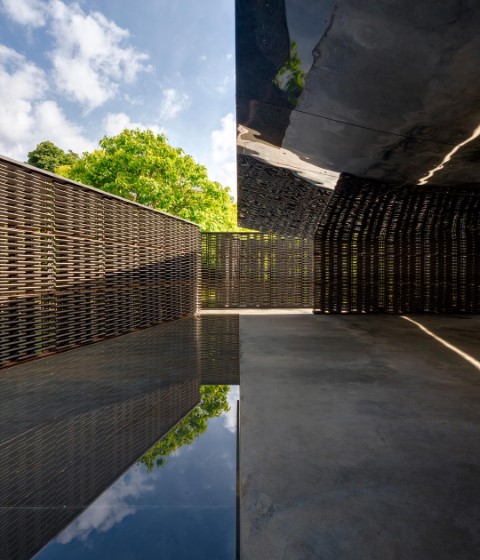It was one of the best pavilions carried out among all the proposals made for the Serpentine Gallery, a true pavilion or summer folie in the gardens of Hyde Park. Brilliant, smart, and the reflection of a daydream, about the pavilion, on issue 19 of METALOCUS, I wrote, below:
1. A floor platform was extended from the east side of the Gallery across the lawn, ending at the cross path at a height of one meter where a set of stairs brought visitors back to ground level. The platform was 10 meters width, which directly related to to the width of the Serpentine's North Gallery. Constructed from lightweight steel structural beams, creating a frame to support a floor surface of perforated metal sheets. Both elements were galvanized. The central area within the walled structured a number of mobile seating/table units, which could be arranged by the visitor during the day for eating, drinking or watching footage of previous talks and activities. The units could be moved to form a more formal seating arrangement when the space was used for talks and film screenings.
2. Where the floor platforms was widened, a circular enclosure was created by fixing a series of translucent polycarbonate wall panels to the perimeter. This wall was 5 meters in height. An inner circular wall constructed from the same material was set inside the outer wall, with a space of 1.6 metres between the two. These two walls were held in position by a series of tensioned steel cables.
3. The Pavilion design incorporated a helium and air filled inflatable roof that could be raised and lowered to accommodate the activities within the structure. It provided protection from the weather - shade at the height of summer and rain and wind cover in the autumn. The inflatable roof was ovoid in shape and extended to a maximum height of 24 meters when opened. In the closed position the height was 20 metres. Although higher than the Gallery building, it was not higher than some of the trees surrounding. The roof was fabricated from semi-clear PVC-coated polyester. The base of the 5 inflatable was hollowed out to produce a cubic void 10 metres by 10 metres by four metres high. The inflatable roof was held securely in position by cables attached to four electrical winches, which in turn were anchored to the ground.
The Pavilion was constructed after the putting on hold of the initial offer by MVRDV, who received strong criticism from the London press for a certain degree of deification in their project.
Description of project by Rem Koolhaas and Cecil Balmond
The Serpentine Pavilion 2006 is co-designed by Pritzker Prize-winning architect Rem Koolhaas and structural designer Cecil Balmond. The centrepiece of the design is a spectacular ovoid-shaped inflatable canopy that floats above the Serpentine's lawn. Made from translucent material, the structure is illuminated from within at night. The canopy will be raised into the air or lowered to cover the amphitheatre below according to the weather.
The walled enclosure below the canopy functions both as a café and forum for daily televised and recorded public programmes including live talks and film screenings in the Time Out Park Nights at the Serpentine Gallery programme. Highlights include two 24-hour interview marathons (convened by Koolhaas and Hans Ulrich Obrist) with leading politicians, architects, philosophers, writers, artists, film-makers and economists exposing the hidden and invisible layers of London.
A major exhibition of works by the German artist, Thomas Demand, was shown at the Serpentine during this period. Demand developed work to be included in the Serpentine Gallery Pavilion 2006.
Rem Koolhaas said: "The 2006 Serpentine Pavilion will be defined by events and activities. We are proposing a space that facilitates the inclusion of individuals in communal dialogue and shared experience."
Cecil Balmond said: "These Pavilions have evolved with various structural typologies and materials, provoking a debate on architecture; this year the exploration continues not only with typology and material but with the very definition of Pavilion."
Each Summer, the Serpentine commissions an internationally acclaimed architect to design a temporary Pavilion for its lawn. The programme is unique worldwide. Conceived by Julia Peyton-Jones, Director, Serpentine Gallery, the project represents a rare opportunity for architects to create a more experimental structure in the United Kingdom, where none of those invited has ever built before. Those selected previously are Zaha Hadid, 2000, Daniel Libeskind with Arup, 2001, Toyo Ito with Arup, 2002, Oscar Niemeyer, 2003, MVRDV, 2004 (unrealised) and Álvaro Siza and Eduardo Souto de Moura with Cecil Balmond – Arup, 2005.






























































